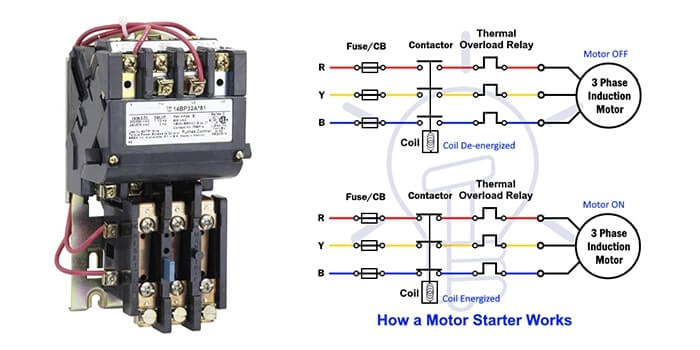Motor Starters are electrical devices that are used to start and stop a motor safely. They are similar to relays and switch powers ON/OFF – although, unlike a relay, it also provides a low voltage and overcurrent protection.
Motor Starters serve the functions of safely starting/stopping a motor, reversing the motor’s direction, or protecting the motor from low voltage and overcurrent. A motor starter comprises two main components that complement each other to control and protect the motor. These are,
– Electrical Contractor: This contractor switches the power supply of a motor ON/OFF by making/breaking the contact terminals.
– Overload Protection Circuit: This circuit protects the motor from potential harm due to overload conditions. A huge current through the rotor may damage the winding as well as other appliances connected to the supply. It senses the current and breaks the power supply.

There are different types of motor starters, such as,
– Wye-delta open transmission is a somewhat standard electromagnetic starter system designed to safely reduce the voltage in the operation of major commercial equipment. The system is suitable for and often implanted in the operation of air compressors and pumps.
– Soft-start solid-state, often used in most major commercial equipment – a soft start motor starter is a reduced voltage starter that performs its function via the use of fluid, magnetic forces, or steel shot to lower startup current and control torque. Soft-start motor starters are frequently used in generators, conveyor systems, and other general-purpose functions.
– Wye-delta starter OEM, a system that features sub-panel mounting, 120-volt coils, and a starter wye-delta timer for control systems that initially refrain from incorporating timer functions.
Importance of Motor Starters
Motor starters are one of the major inventions for motor control applications. As the name may imply, a starter is an electrical device that controls the electrical power needed to start a motor. These electrical devices are also used to stop, reverse, and protect electric motors.
A motor starter is also very important for starting an induction motor. This is due to its low rotor impedance, which depends on the slip of the induction motor, which is the relative speed between the rotor and stator. Induction motors have a high inrush current that is 5 to 8 times the normal rated full load current. Such volumes of current can easily damage or burn the windings of the motor rendering the machines useless. It can also cause a huge dip in the supply voltage, which leads to damaging other appliances connected to the same particular line.
In order to protect the motor from such huge volumes of currents, motor starters are used to limit the initial current for shorter durations at startup, and once the motor attains a certain speed, the normal power supply to the motor is resumed.
How do Motor Starters Work?
Motor starters usually consist of two devices, a contractor that completes the circuit to the motor and an overload relay that monitors the current the motor draws. This overload shielding device is set to a pre-determined maximum load that the motor can safely handle. When a condition occurs that causes the motor to surpass the maximum load, the device opens the motor starter control circuit, and then the motor is turned off.
Conclusion
When an electric motor is started, a large amount of current is required to turn the motor. This current is supplied by the motor starter. The motor starter consists of a contactor, which is an electrically controlled switch, and a set of coils. When the contactor is energized, the coils create a magnetic field that closes the contactor, allowing current to flow to the motor.



